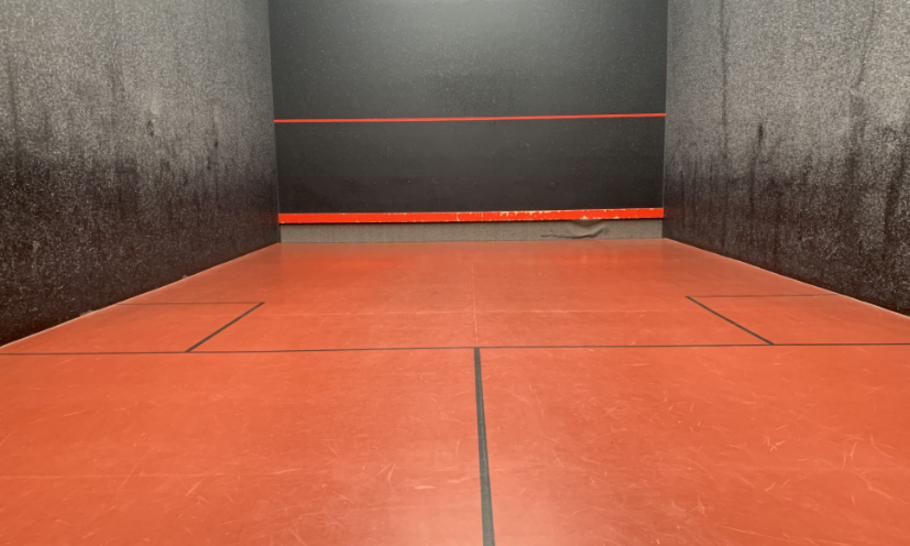Rackets: a game for women — not sissies

Wellington Rackets Court
When I was at school, one of those prim, single-sex private ones, we were forbidden to kick a ball in the playground. “Girls mustn’t do that.” Oh, how I longed to kick that ball. It was the beginning of a lifelong battle against sexism, and not just in sport.
And then last week I witnessed the most spectacular sporting occasion of what is considered to be an extremely dangerous sport, one which girls wouldn’t have been allowed near when I was a kid: the Ladies’ Rackets World Championships, between 28-yr-old Lea van der Zwalmen and 33-yr-old Claire Fahey.
I imagine a fair number of readers won’t know anything about the sport of rackets. It is, to be fair, a tad obscure. But the rules are simple enough to follow and similar to squash.
The layout is just like a squash court, except that, with a massive 30-by-60 foot floor area and a minimum 30 foot height, it’s roughly three times the size. The racket head is small, similar to an old-fashioned squash racket and a little longer. The wall and floor are made of smooth stone or concrete and the ball is roughly the size of a golf ball and it zips round the court at incredible speed. It can leave the racket at up to 180 mph. And that ball fits beautifully into the eye socket – I know of two players who lost an eye playing the game.
If you have ever experienced that exquisite feeling of a perfectly struck golf ball, a rackets ball hit out of the sweet spot is even more exhilarating and the sound off the front wall is like a rifle crack. It’s addictive, but it’s not a game for sissies.
During a match, the person marking the score shouts “play” after each stroke to indicate that it’s safe for that person to strike the ball without potentially injuring the opponent. If a player thinks they might do so, they can stop the rally and ask for a let. This is all an attempt to make the game a little safer.
I had a go at the game around thirty years ago when virtually no women played (deemed too dangerous for us…) and was persuaded to stop playing by the male rackets pros. But another reason so few women played the game at that time is that it’s practised mainly in what were all-male public schools. Many of those schools, such as Rugby and Winchester, now take girls which gives them a chance to try out the game. By 2015 a Ladies’ World Championship was established and was won by Lea van der Zwalmen, and she’s held onto that title ever since.
Lea now lives in Bordeaux where there is no rackets court and therefore no chance to practise. She has a full-time job and is also the chair of Bordeaux Real Tennis Club. The game in Bordeaux was not in good shape and she has totally reinvigorated the club, encouraging interclub matches and setting up a vibrant social side. The members love her for it.

Lea van der Zwalmen (photo accredited to Tim Edwards)
Claire, on the other hand, is a professional Real Tennis player, at which she is current Ladies’ World Champion and, being based in the UK, within fairly easy reach of a rackets court. Her husband, Rob Fahey, as the former male world champion at Real Tennis, is a pretty useful hitting partner. Being a full-time professional, she is also seriously fit. No-one has been concurrent World Champion at both rackets and Real Tennis, so Claire was pretty desperate to make that happen.
Lea came over just four days before the match and that was the extent of time she had to practise before the big match. And, unlike Claire, she hadn’t had the time to spend regularly working out in the gym. On paper, she was at a serious disadvantage.
The match turned out to be a nail-biter and, buoyed by a significant French fan club who’d followed her from Bordeaux, Lea somehow emerged the winner by 3-2 in a best of 5 games match, despite losing the first two games. Towards the end, she appeared to be physically fading but got through by sheer willpower and natural talent. Her backhand is one of the most beautiful I’ve seen, on a par with Roger Federer in its smoothness and style. To produce such an effortless stroke when the ball is travelling at that speed is quite some achievement.

(photo accredited to Tim Edwards)
The quality of play was quite sensational. The power, movement and skill were all breathtaking. As she told me afterwards: “I’m in shock. I can’t believe I came back from being so far behind. I really didn’t think I had it in me. I was so amazed I had to watch it on YouTube that night to really understand what had happened.” If you also want to watch the match you can do so here.
And then, just a few days later, I went to Wembley for the women’s FA Cup Final between Manchester United and Spurs – 76,000 spectators for a women’s match. That would have been unthinkable just a few years back. Other female sports, such as golf, cricket and rugby, have also enjoyed increased visibility and popularity, even if salaries and prize money still disproportionately favour the men. But that’s the next battle. In the meantime, we should relish the strides being made in women’s sport.
A Message from TheArticle
We are the only publication that’s committed to covering every angle. We have an important contribution to make, one that’s needed now more than ever, and we need your help to continue publishing throughout these hard economic times. So please, make a donation.




